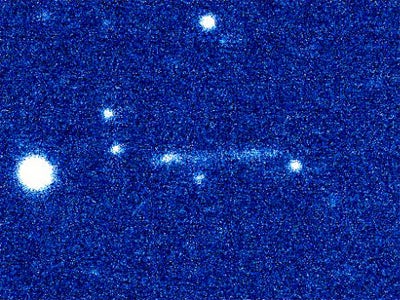British amateur astronomer Richard Miles has discovered the fastest rotating natural object known in our solar system.
His observations, made using a telescope normally shared by students and professional scientists, have proved that the newly-discovered asteroid, 2008 HJ, is revolving once every 42.7 seconds, classifying it is as a superfast rotator. His discovery will boost our sparse knowledge of near-Earth asteroids and is another successful find for the Faulkes Telescope near-Earth asteroid project.
Miles made his discovery April 29 using the Faulkes Telescope South at Siding Spring, Australia, which he operated remotely via the Internet from his home in Dorset. Confirmation of his discovery was formally announced by the International Astronomical Union on May 22. The previous record holder was asteroid 2000 DO8, discovered eight years ago and found to rotate once every 78 seconds. The Science and Technology Facilities Council (STFC) was involved in the initial set-up of the Faulkes Telescope Project and continues to provide support.
This latest discovery is the most recent outcome of a new project to use the Faulkes Telescopes in Hawaii and Australia to survey the properties of small near-Earth asteroids. Schools and colleges in the United Kingdom have participated in the project, which in April found that asteroid 2008 GP3 rotates once every 11.8 minutes. Asteroid 2008 HJ was only the fourth object observed as part of this study.
The observations suggest that 2008 HJ is a compact, stony object, smaller than a tennis court, yet probably having a mass in excess of 5,000 tons. It was moving at almost 100,000 miles per hour (45 kilometers per second) when it hurtled past Earth in late April. Despite being classified as a near-Earth asteroid, it never posed a threat to our planet.
Paul Roche, director of the Faulkes Telescope Project at Cardiff University, said: “A discovery like this demonstrates the capabilities of amateur astronomers and students to produce exciting scientific results if given the right tools. By providing Richard with access to a big telescope, we have smashed the previous record, and opened up the search for even faster objects.”
The early success for the Faulkes Telescope near-Earth asteroid project bodes well for the future and should prove encouraging to schools, colleges, and other amateur astronomers looking to participate. One challenge will be to find objects spinning even faster than 2008 HJ. Cooperation between all observing groups, whether they are astronomers or students, will be essential if asteroid rotation rates are to be accurately identified.
Our knowledge of the near-Earth population of small asteroids is very sparse, so schools and others can contribute directly to our understanding of these nearest neighbors. Most of these objects are probably fragments ejected from collisions between larger bodies which took place some time in the distant past. Other objects may have originated when the solar nebula was formed over 4.6 billion years ago.










